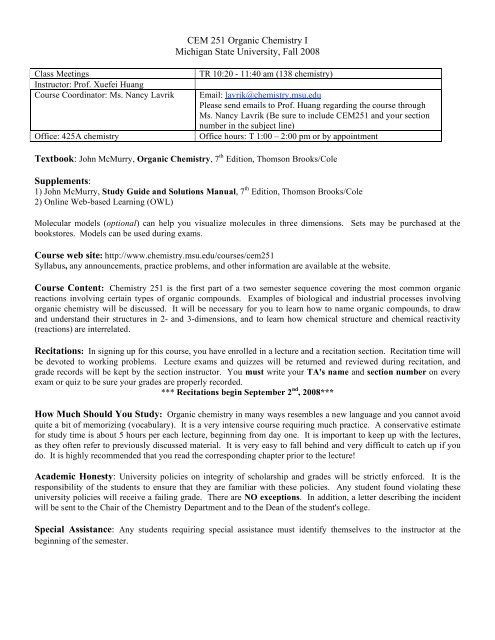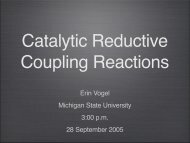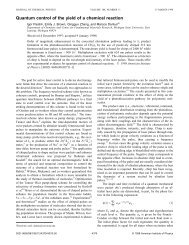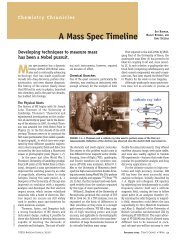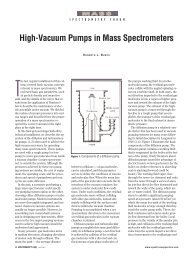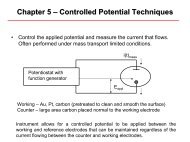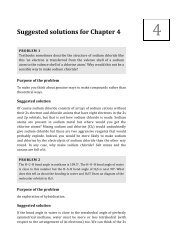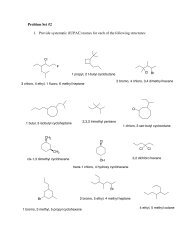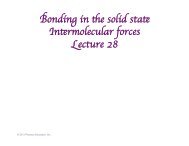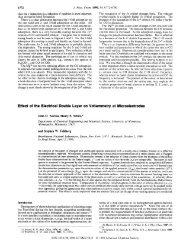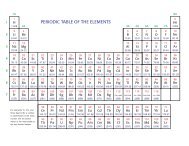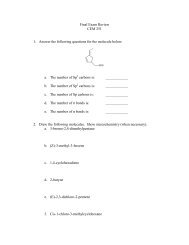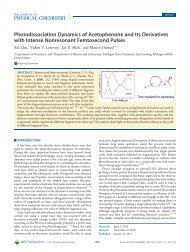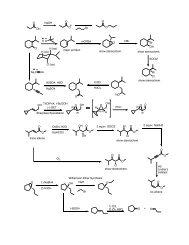CEM 251 Organic Chemistry I Michigan State University, Fall 2008 ...
CEM 251 Organic Chemistry I Michigan State University, Fall 2008 ...
CEM 251 Organic Chemistry I Michigan State University, Fall 2008 ...
You also want an ePaper? Increase the reach of your titles
YUMPU automatically turns print PDFs into web optimized ePapers that Google loves.
<strong>CEM</strong> <strong>251</strong> <strong>Organic</strong> <strong>Chemistry</strong> I<br />
<strong>Michigan</strong> <strong>State</strong> <strong>University</strong>, <strong>Fall</strong> <strong>2008</strong><br />
Class Meetings<br />
Instructor: Prof. Xuefei Huang<br />
Course Coordinator: Ms. Nancy Lavrik<br />
Office: 425A chemistry<br />
TR 10:20 - 11:40 am (138 chemistry)<br />
Email: lavrik@chemistry.msu.edu<br />
Please send emails to Prof. Huang regarding the course through<br />
Ms. Nancy Lavrik (Be sure to include <strong>CEM</strong><strong>251</strong> and your section<br />
number in the subject line)<br />
Office hours: T 1:00 – 2:00 pm or by appointment<br />
Textbook: John McMurry, <strong>Organic</strong> <strong>Chemistry</strong>, 7 th Edition, Thomson Brooks/Cole<br />
Supplements:<br />
1) John McMurry, Study Guide and Solutions Manual, 7 th Edition, Thomson Brooks/Cole<br />
2) Online Web-based Learning (OWL)<br />
Molecular models (optional) can help you visualize molecules in three dimensions. Sets may be purchased at the<br />
bookstores. Models can be used during exams.<br />
Course web site: http://www.chemistry.msu.edu/courses/cem<strong>251</strong><br />
Syllabus, any announcements, practice problems, and other information are available at the website.<br />
Course Content: <strong>Chemistry</strong> <strong>251</strong> is the first part of a two semester sequence covering the most common organic<br />
reactions involving certain types of organic compounds. Examples of biological and industrial processes involving<br />
organic chemistry will be discussed. It will be necessary for you to learn how to name organic compounds, to draw<br />
and understand their structures in 2- and 3-dimensions, and to learn how chemical structure and chemical reactivity<br />
(reactions) are interrelated.<br />
Recitations: In signing up for this course, you have enrolled in a lecture and a recitation section. Recitation time will<br />
be devoted to working problems. Lecture exams and quizzes will be returned and reviewed during recitation, and<br />
grade records will be kept by the section instructor. You must write your TA's name and section number on every<br />
exam or quiz to be sure your grades are properly recorded.<br />
*** Recitations begin September 2 nd , <strong>2008</strong>***<br />
How Much Should You Study: <strong>Organic</strong> chemistry in many ways resembles a new language and you cannot avoid<br />
quite a bit of memorizing (vocabulary). It is a very intensive course requiring much practice. A conservative estimate<br />
for study time is about 5 hours per each lecture, beginning from day one. It is important to keep up with the lectures,<br />
as they often refer to previously discussed material. It is very easy to fall behind and very difficult to catch up if you<br />
do. It is highly recommended that you read the corresponding chapter prior to the lecture!<br />
Academic Honesty: <strong>University</strong> policies on integrity of scholarship and grades will be strictly enforced. It is the<br />
responsibility of the students to ensure that they are familiar with these policies. Any student found violating these<br />
university policies will receive a failing grade. There are NO exceptions. In addition, a letter describing the incident<br />
will be sent to the Chair of the <strong>Chemistry</strong> Department and to the Dean of the student's college.<br />
Special Assistance: Any students requiring special assistance must identify themselves to the instructor at the<br />
beginning of the semester.
Lecture and Examination Schedule:<br />
Dates Chapters Subjects<br />
August 26, 28 1,2 Structure and Bonding | Acids & Bases<br />
Sept. 2,4 3 <strong>Organic</strong> Compounds: Alkanes & Stereochemistry<br />
Sept. 9, 11 4 <strong>Organic</strong> Compounds: Cycloalkanes &<br />
Stereochemistry<br />
Sept 16, 18 5 Overview of <strong>Organic</strong> Reactions<br />
(Tuesday Sept 16-Quiz 1: Chap 1,2,3,4)<br />
Sept. 23, 25 6 Alkenes: Structure & Reactivity<br />
Sept. 30, Oct. 2 7 Alkenes: Reactions & Synthesis<br />
Oct. 7 Tuesday (1st EXAM) 1-7<br />
Oct. 9 8 Alkynes<br />
Oct. 14, 16 9 Stereochemistry<br />
Oct. 21 10 Organohalides<br />
Oct. 23, 28, 30 11 Reactions of Organohalides (Alkyl halides)<br />
(Thursday Oct 23rd-Quiz 2: Chap 8, 9, 10)<br />
Nov. 4, 6 14 Conjugated compounds and UV spectroscopy<br />
Nov. 11, 13 12 Structure Determination: MS, IR<br />
Nov. 18 Tuesday (2nd EXAM) 8-12, 14<br />
Nov. 20, 25, Dec. 2 13 Structure Determination NMR<br />
Dec. 4<br />
Review<br />
(Thursday Dec 4-Quiz 3: Chap 13)<br />
(FINAL EXAM)<br />
Comprehensive<br />
Date: December 11<br />
Location: (To be announced)<br />
8:00-10:00 pm<br />
Please turn off all cell phones during lectures and exams. No electronic devices will be needed or<br />
allowed during exams.<br />
Quiz Date: Sept. 16 th , Oct. 23 rd , Dec. 4 th<br />
Exam Date: Oct. 7 th , Nov. 18 th<br />
Final Exam Date: Dec. 11 th , 8:00-10:00 pm
Grades: Your grade in this course will come from the sum of 3 quizzes, 2 hourly exams, and the final exam. Extra<br />
credit opportunities are available.<br />
3 Quizzes 3 x 25 = 75 points<br />
2 Hourly Exams 2 x 100 = 200 points<br />
Final Exam<br />
Total<br />
Bonus points<br />
1 x 200 = 200 points<br />
475 points<br />
Maximum 50 points<br />
Online Web-Based Learning (OWL) Bonus Points: (40 points) After we finish each chapter in lecture,<br />
electronically-graded homework OWL will be assigned online for you to work. You will need to purchase an access<br />
code for OWL. For every three questions answered correctly on OWL, you will receive one bonus point. The total<br />
maximum number of points one can receive from OWL is 40.<br />
To access OWL:<br />
1. Go to http://owl.cengage.com/<br />
2. Click on the link for login or registration.<br />
3. Choose the textbook: <strong>Organic</strong> <strong>Chemistry</strong>, 7th Edition; McMurry<br />
4. Choose the institution: <strong>Michigan</strong> <strong>State</strong> <strong>University</strong> - East Lansing, <strong>Michigan</strong><br />
5. Click on the blue arrow next to the department, <strong>Chemistry</strong> Department, on the User Login and Student Registration:<br />
Select Department page.<br />
6. On the OWL User Login page, fill in your login (please use your last name as login name) and password. This is the<br />
correct page to bookmark for future use.<br />
Recitation Attendance Bonus Points: (10 points) You can receive a bonus point for each FULL recitation<br />
attended. You will sign an attendance sheet at the end of each recitation. The maximum recitation attendance number<br />
of bonus points one can receive is 10.<br />
Your course grade can be ESTIMATED from the following scale:<br />
Total Points Earned<br />
Grade<br />
≥ 418 4.0<br />
380 – 417 3.5<br />
342 – 379 3.0<br />
305 – 341 2.5<br />
275 – 304 2.0<br />
250 – 274 1.5<br />
228 – 249 1.0<br />
< 227 0.0<br />
There will be no makeups for quizzes and lecture exams. If you have a legitimate reason to miss a lecture<br />
exam, we may prorate your final exam score (scale to 300 points).<br />
Final Exam: The final (200 points) is comprehensive. A picture ID must be presented in order to take the final.<br />
<strong>University</strong> rules stipulate that a course grade of 0.0 is given to students who do not take the final exam. Final exams<br />
will be kept on file until the middle of the following semester and then destroyed. If you wish to check your final exam<br />
score see cemscores: http://cemscores.msu.edu<br />
Posting of quiz/exam scores: After the quiz/exam has been graded and recorded, you can check the cemscores site<br />
for your grade: http://cemscores.msu.edu<br />
To access cemscores throughout the semester, you can bookmark the link.<br />
The cemscores link will be activated after the posting of Quiz 1 grades.
Policy on Returning Exams and Regrading:<br />
a) Exams and Quizzes will be returned only during a regularly scheduled recitation meeting.<br />
b) Regrade requests directed at the instructor must be written on the exam or quiz and signed by you and your TA at<br />
recitation. The entire test will be regraded by me.<br />
c) No exam which has left the recitation room in possession of the student will be considered for regrading.<br />
d) If you miss your own recitation, you may make arrangements with your TA to pick up your test in another one of<br />
his/her regularly scheduled sections.<br />
e) Students are not to enter research labs in search of TAs, since potentially dangerous chemicals and equipments<br />
are always present in the <strong>Chemistry</strong> Building.<br />
Problem Sets<br />
Problems at the end of each chapter are assigned. They will not be collected and graded. However, it is highly<br />
recommended that you attempt the problems to gauge your understanding of the material and test your readiness for the<br />
exams. Do not look at the solutions manual too quickly without trying your best to solve the problems. Remember, if<br />
you are not able to solve the problems, it means that you have not understood the subject matter as well as you think<br />
you do. Go back and read the notes and the textbook, do not just look up the answer! It is much more beneficial for<br />
you to struggle through the problem and learn, as opposed to looking it up in the solutions manual.<br />
Homework Problems:<br />
ALL IN-TEXT PROBLEMS ARE RECOMMENDED; ADDITIONAL PROBLEMS ARE ASSIGNED BELOW:<br />
Chapter 1 1.21 - 1.26, 1.28 – 1.32, 1.34, 1.35, 1.42<br />
Chapter 2 2.23 - 2.37, 2.32 – 2.35, 2.37 – 2.39, 2.43 – 2.45, 2.52<br />
Chapter 3 3.21 – 3.24, 3.27 – 3.29, 3.34, 3.39, 3.40, 3.42, 3.52<br />
Chapter 4 4.21 – 4.28, 4.32, 4.35 – 4.37, 4.43, 4.49<br />
Chapter 5 5.20, 5.22, 5.23, 5.30, 5.31, 5.37, 5.39, 5.40<br />
Chapter 6 6.23 – 6.26, 6.29, 6.39, 6.40, 6.45, 6.46, 6.51<br />
Chapter 7 7.24 – 7.27, 7.35, 7.41 – 7.43<br />
Chapter 8 8.18, 8.19, 8.21, 8.25, 8.26, 8.28, 8.31, 8.32, 8.33, 8.37, 8.41<br />
Chapter 9 9.31, 9.33, 9.37, 9.39, 9.42, 9.44, 9.45, 9.50, 9.55, 9.58, 9.66, 9.79<br />
Chapter 10 10.17 thru 10.24, 10.29, 10.31 thru 10.37, 10.39, 10.42<br />
Chapter 11 11.25 thru 11.37, 11.39, 11.40, 11.47 - 11.49<br />
Chapter 12 12.18, 12.25, 12.27 – 12.28, 12.31, 12.32 - 12.36, 12.43<br />
Chapter 13 13.31 thru 13.34, 13.37, 13.38, 13.40, 13.42, 13.43, 13.48, 13.49 thru 13.54,<br />
13.57.<br />
Chapter 14 14.16, 14.17, 14.20 thru 14.27, 14.32, 14.33, 14.37, 14.40, 14.45


